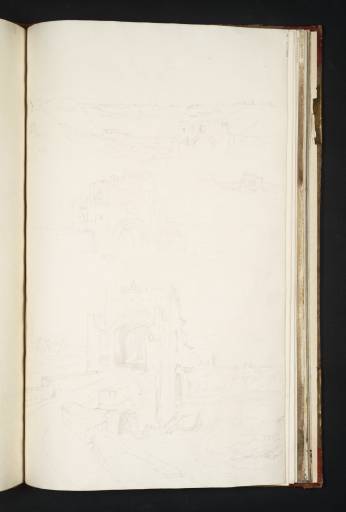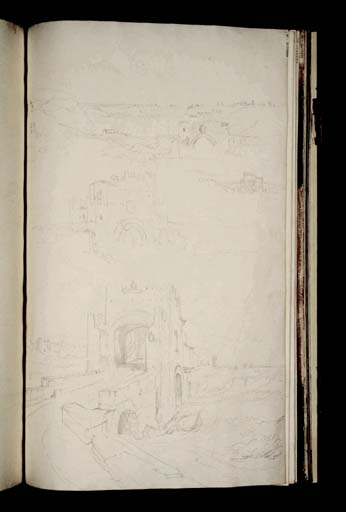Joseph Mallord William Turner Four Sketches of Ponte Nomentano, Rome 1819
Image 1 of 2
Joseph Mallord William Turner,
Four Sketches of Ponte Nomentano, Rome
1819
Joseph Mallord William Turner 1775–1851
Folio 40 Recto:
Four Sketches of Ponte Nomentano, Rome 1819
D16128
Turner Bequest CLXXXVII 40
Turner Bequest CLXXXVII 40
Pencil on white wove paper, 403 x 255 mm
Inscribed by John Ruskin in blue ink ‘40’ top right
Stamped in black ‘CLXXXVII 40’ top right, ascending right-hand edge
Inscribed by John Ruskin in blue ink ‘40’ top right
Stamped in black ‘CLXXXVII 40’ top right, ascending right-hand edge
Accepted by the nation as part of the Turner Bequest 1856
Exhibition history
1904
National Gallery, London, various dates to at least 1904 (300).
References
1904
E.T. Cook and Alexander Wedderburn (eds.), Library Edition: The Works of John Ruskin: Volume XIII: Turner: The Harbours of England; Catalogues and Notes, London 1904, no.300, pp.384, 623, as ‘Bridges in the Campagna’.
1909
A.J. Finberg, A Complete Inventory of the Drawings of the Turner Bequest, London 1909, vol.I, p.556, as ‘Bridges in the Campagna. Exhibited Drawings, No.300, N.G.’.
1920
D[ugald] S[utherland] MacColl, National Gallery, Millbank: Catalogue: Turner Collection, London 1920, p.86.
1984
Cecilia Powell, ‘Turner on Classic Ground: His Visits to Central and Southern Italy and Related Paintings and Drawings’, unpublished Ph.D thesis, Courtauld Institute of Art, University of London 1984, p.426, as ‘Sketches of Ponte Nomentano’.
A large number of studies from the Naples: Rome C. Studies sketchbook represent variant views of the Roman Campagna, the area of countryside encircling the outskirts of the Eternal City (Tate D16122–D16139; Turner Bequest CLXXXVII 34–51). Cecilia Powell first identified the subject of the sketches on this page as Ponte Nomentano, an ancient bridge which spans the River Aniene approximately three miles north-east of the city walls, and approximately one mile upstream from the Ponte Salario.1 As Turner’s studies show, the bridge comprised one large central arch with smaller side arches, whilst the crossing was fortified by an eclectic medieval development of embattled towers and walls. He studied this unusual combination from a variety of angles. The uppermost drawing records the bridge face on from the north-east, on the Monte Sacro side of the river. In the far distance can be seen the arches of the Claudian Aqueduct and the small dome of the temple of Minerva Medica. The second sketch from the top is a smaller study which repeats the view from the opposite side, and the third sketch from the top depicts an oblique prospect of the bridge from the eastern end. The most detailed sketch is the one at the bottom of the page which depicts the western end from the Rome bank of the river.
By the nineteenth century, exploration of the city’s environs had become as much part of the Roman experience as its architecture and monuments. Turner’s forays into the Campagna followed a long artistic tradition established during the seventeenth century by Claude Lorrain (circa 1600–1682) and Nicolas Poussin (1594–1665). The two French masters had famously made a number of sketching trips along the banks of the Tiber north of the city; indeed the countryside between the Porta del Popolo and the Ponte Molle had popularly become known as the ‘Promenade de Poussin’. The Ponte Nomentano was one of a number of landmarks which had become an established motif through the repertory of the ‘vedute’ tradition, see for example a drawing by Richard Wilson (Tate, T03026).2 Turner made a number of other sketches on folio 39 (D16127), on the inner front cover of the sketchbook (D41405) and on D40079 (the verso of D16129; CLXXXVII 41). See also the Small Roman C. Studies sketchbook (Tate D16465; Turner Bequest CXC 50).
See for example Giuseppe Vasi, Ponte Nomentano 1754, reproduced at http://www.romeartlover.it/Vasi82.htm accessed March 2009 . Also early nineteenth century views by Jean-Baptiste-Camille Corot, Johann Christoph Erhard and Carl Rottmann, reproduced in Peter Galassi, Corot in Italy: Open-Air Painting and the Classical-Landscape Tradition, New Haven and London 1991, pp.166–7; and Ernst Fries, reproduced in Philip Conisbee, Sarah Faunce and Jeremy Strick, In the Light of Italy: Corot and early Open-Air Painting, exhibition catalogue, National Gallery of Art, Washington 1996, no.82, p.215.
Verso:
Blank, save for inscription by an unknown hand in pencil ‘[?M]’ bottom right, ascending right-hand edge.
Nicola Moorby
March 2009
How to cite
Nicola Moorby, ‘Four Sketches of Ponte Nomentano, Rome 1819 by Joseph Mallord William Turner’, catalogue entry, March 2009, in David Blayney Brown (ed.), J.M.W. Turner: Sketchbooks, Drawings and Watercolours, Tate Research Publication, December 2012, https://www


